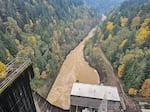
Water downstream of Green Peter dam on the South Santiam River, seen here on Nov. 3, turned muddy after a deep drawdown of the dam’s reservoir.
Courtesy of Chase Berrier. / Courtesy of Chase Berrier
Several cities in Oregon’s Willamette Valley have seen excessively muddy water flowing into their drinking water systems as a result of upstream reservoirs being drained, the Salem Statesman Journal has reported.
The Statesman Journal first broke the news last week that the U.S. Army Corps of Engineers’ deep reservoir drawdowns, done because of a court order to aid migrating salmon populations, were taxing community water plants and causing private wells to dry up. This week, the newspaper reported that while the water remains safe to drink, the city of Sweet Home had staff working 24 hours per day to filter it and some residents had switched to bottled water because of their tap water’s color and smell.
The strain on drinking water plants is an unintended consequence of measures that environmental advocates, tribes, many scientists and a federal judge consider the best opportunity to save endangered salmon in the Willamette River valley.
Baby salmon who need to migrate to the ocean often get trapped in reservoirs behind the dams, which on some Willamette tributaries block between 70% and 100% of the fish’s historic spawning habitat. Drawing reservoirs down to nearer their original riverbeds is meant to flush the young salmon through gates in the dam wall that are usually too deep underwater for the fish to find. A judge ordered the drawdowns in 2021 after a lawsuit from several environmental groups alleging the Corps’ dam operations were jeopardizing salmon populations.
In October, OPB and ProPublica reported on the Corps of Engineers plan to build massive floating fish collectors to trap and truck salmon past dams, to avoid the need for drawdowns on certain reservoirs. OPB and ProPublica reported that scientists have cast doubt on the effectiveness of the $1.9 billion Corps plan, and that many of the interests the Corps said it needed to protect by maintaining reservoirs — namely electric utilities, farmers and recreational boaters — would be only marginally impacted by drawdowns each fall.
However, the heavy amounts of sediment in the water, known as turbidity, now have many community members vocally upset over the Corps’ implementation of drawdowns. The muddy water has also dampened fishing opportunities in some communities. The mayor of Sweet Home is now seeking a pause on the drawdowns, and Oregon’s congressional delegation is also paying close attention to the situation, according to the Statesman Journal.
The extent of the turbid waters caught many off guard.
The Corps of Engineers told the Statesman Journal earlier this week that the agency did anticipate muddy water and warned municipalities. But as the paper also reported, the Corps previously said drinking water would not be affected by the court-ordered drawdowns.
In multiple interviews with OPB and ProPublica about the potential impacts of drawdowns, Corps officials did not mention the potential for excessive mud to affect drinking water.
Large pulses of mud are a known consequence of reservoir flushing, however. A study at one of the Corps previous experiments with annual drawdowns at the smaller Fall Creek reservoir, also in the Willamette Valley, found the drawdown initially sent significant amounts of sediment downstream. After two consecutive years of drawdowns, the study found the amount of sediment that made it downstream dropped substantially.
The concerns over rivers looking like chocolate milk prompted the environmental groups, which sued to secure the drawdowns, to issue a press release stating support for the affected towns. They said that “the consequences of the Corps’ long-standing failure to protect wild fish should not fall on the shoulders of the community of Sweet Home.”
The Native Fish Society, Wild Earth Guardians and Northwest Environmental Defense Center collectively called for immediate relief for the impacted communities, and said they would work with government officials to craft a solution.
That relief could include money for homeowners who have been forced to drill deeper wells after theirs went dry, which can cost tens of thousands of dollars, or for local governments who are worried their overworked treatment systems could cost millions of dollars to replace.
A spokesperson for the Corps of Engineers, however, told the Statesman Journal that it could not pay for such things unless authorized by Congress.
